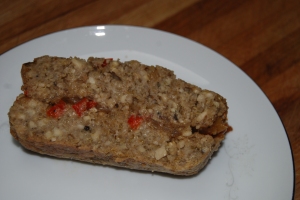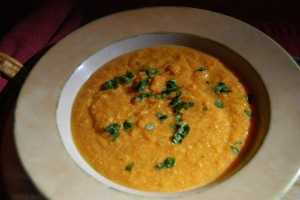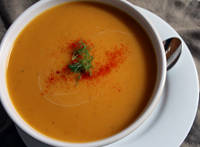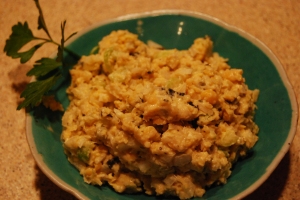It’s holiday time again, and many of us are thinking about a special Easter dinner. What do you prepare if it’s not the traditional Easter ham or roast, and you want to eat a healthy, plant-based meal?
There are a growing number of helpful resources available for people who are interested in eating a more  plant-based diet. One great resource is the Jazzy Vegetarian.
plant-based diet. One great resource is the Jazzy Vegetarian.
Thanks to the Jazzy Vegetarian, I’m sharing an absolutely delicious vegan feast that is easy to prepare! The menu is….Crispy Portobello Steaks, Maple Sweet Potatoes, Roasted Asparagus with Garlic and Tomatoes, and Luscious Raspberry Parfaits.
Here are the recipes!
By the way, did you know 1 cup of sliced portobello mushrooms has 5 grams of protein and only 1 gram of fat? Check here for nutritional qualities of mushrooms!
Crispy Portobello Steaks
Makes 4 servings
In this recipe, a savory, crunchy coating perfectly complements the meaty texture and mouthwatering taste of portobello mushrooms. The method was inspired by my grandma’s trick of using mayonnaise to keep chicken moist when baking. Please see note below for a low-fat version of this tasty recipe!
4 portobello mushrooms, stemmed
3 cups cornflakes
1 teaspoon italian seasoning
1 teaspoon garlic powder
1⁄4 teaspoon sea salt
1⁄8 to 1⁄4 teaspoon freshly ground pepper
2 tablespoons extra-virgin olive oil
1⁄3 cup vegan mayonnaise (see NOTE below)
2 teaspoons dijon mustard
2 teaspoons reduced-sodium tamari
Preheat the oven to 400 degrees F. Line a 13 x 9-inch baking pan with parchment paper.
Rinse the portobello mushrooms briefly and pat dry with a clean dish towel, taking care not to break them.
Put the cornflakes, italian seasoning, garlic powder, salt, and pepper in a blender or food processor and process to form crumbs. Transfer to a medium bowl. Add 1 tablespoon of the oil. Stir until the crumbs are evenly coated.
Put the vegan mayonnaise and mustard in a small bowl and whisk until thoroughly blended.
Lay a mushroom upside down on a large plate. Sprinkle 1⁄2 teaspoon of the tamari over the gills, then drizzle with 1 teaspoon of the oil. (For a lower-fat version, omit the olive oil from this step).
Turn the mushroom over and spread one-quarter of the mayonnaise mixture evenly over the top. Spread one-quarter of the cornflake mixture evenly over the top, patting it down firmly and not leaving any holes or gaps. Put the mushroom in the lined pan, right-side up. Repeat with the remaining ingredients.
Tent the baking pan with foil and bake for 20 minutes. Turn the heat down to 375 degrees F, remove the foil, and bake for 10 to 20 minutes, until the mushrooms are fork-tender and the coating is crispy.
Let cool for 5 to 10 minutes to firm up. Cut the mushrooms into thick diagonal slices and serve immediately.
NOTE: For a lower-fat version, omit the vegan mayo and increase dijon mustard to 1/3 cup. Reduce the olive oil to 2 teaspoons. It is still JAZZYLICIOUS!
Maple Sweet Potatoes
Makes 4 servings
This dish pairs well with many entrées and also makes a great addition to any holiday meal. As a bonus, it can be ready in thirty minutes or less.
3 medium sweet potatoes or yams, peeled and cubed
2 tablespoons vegan margarine, plus more as needed
1 tablespoon maple syrup
1⁄4 to 1⁄2 teaspoon pumpkin pie spice
1⁄4 teaspoon sea salt
Steam the sweet potatoes until soft, 20 to 25 minutes. Transfer to a large bowl. Add the margarine, maple syrup, pumpkin pie spice, and salt. Mash with a potato masher until smooth, adding a bit more margarine if the potatoes seem dry. Serve immediately.
Roasted Asparagus with Garlic and Tomatoes
Makes 4 servings
Baking the garlic before adding it to the asparagus gives this dish a mellow, sweet flavor that isn’t overly garlicky. The tomatoes add a pop of texture and also complement the vibrant green color of the delicate asparagus spears.
2 cloves garlic, chopped
3 teaspoons extra-virgin olive oil
1 large bunch slender asparagus spears, trimmed
1/4 to 1/2 teaspoon sea salt
10 to 15 cherry or grape tomatoes
Preheat the oven to 400 degrees F. Line a large, rimmed baking sheet with parchment paper.
Put the garlic in the center of a 12-inch square of aluminum foil. Drizzle with 1 teaspoon of the oil. Wrap the garlic in the foil, crimping the edges to make a tight seal. Bake for 15 to 20 minutes, until golden and soft.
Meanwhile, put the asparagus in a large bowl. Drizzle with the remaining 2 teaspoons of oil and sprinkle with the salt. Toss gently until the asparagus is evenly coated.
Spread the asparagus in a single layer on the lined baking sheet. Unwrap the garlic (carefully, as it will be very hot). Distribute the garlic over the asparagus. Bake for 5 to 10 minutes, depending on the thickness of the asparagus. Scatter the tomatoes over the asparagus and bake for 3 to 5 minutes, until the asparagus is crisp-tender but not mushy.
Arrange the asparagus on a serving platter and spoon the garlic and tomatoes over the top. Serve hot, warm, or chilled.
Luscious Raspberry Parfaits
Makes 3 to 4 servings
This delectably smooth and frosty dessert is a beautiful way to end any meal, and it comes together in just five minutes. It is a lighter alternative to traditional puddings, as it uses tofu rather than eggs and cream. For added elegance and indulgence, serve vegan tea cookies with the parfaits.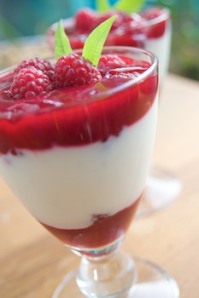
2 1/4 cups frozen raspberries
8 ounces soft regular or silken tofu, drained
3 tablespoons maple syrup
1⁄4 to 1⁄2 teaspoon vanilla extract
Put 5 or 6 raspberries in three champagne glasses or glass dessert dishes. Set aside 3 of the remaining raspberries for garnish. Put the tofu, maple syrup, vanilla extract, and remaining rasp- berries in a blender or food processor and process until smooth and creamy.
Spoon the mixture into the glasses or dessert dishes and garnish each with a raspberry. Serve immediately.
The Jazzy Vegetarian has wonderfully delicious vegan recipes. You can watch her in the kitchen on National Public Television (check local listings) or go to her website www.jazzyvegetarian.com.
JOYFUL EATING!
Related articles
- Well: A Vegan Passover (well.blogs.nytimes.com)



